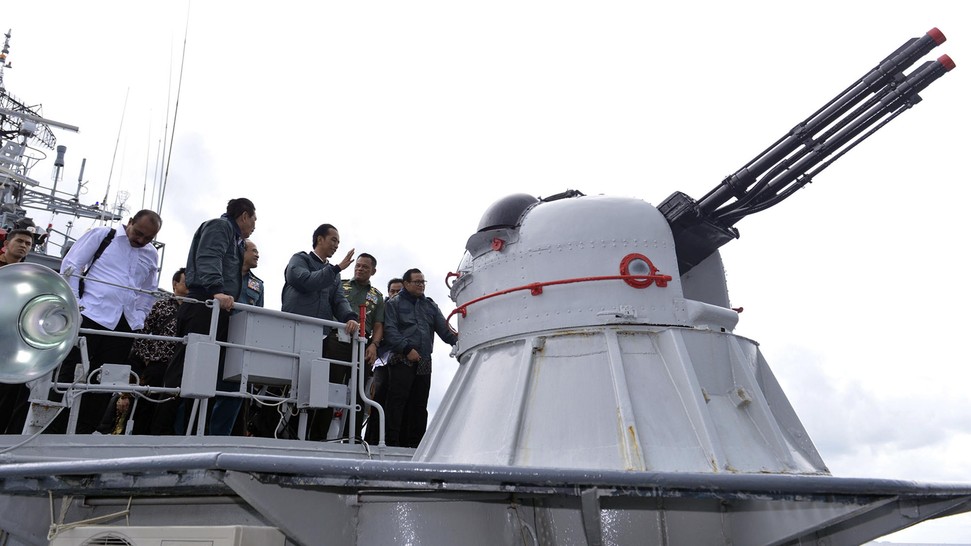Indonesia will never compromise on Natunas, says Jokowi
This handout photograph on Oct 6, 2016, shows Indonesian President Joko Widodo (centre) walking next to Indonesian Military Chief General Gatot Nurmantyo (left) and Air Force Chief of Staff Air Marshal Agus Supriatna (right) during a military drill on the remote Natuna islands. Photo: Presidential Palace via AFP
SINGAPORE — Indonesia will never compromise on its sovereignty in the Natuna Islands, said President Joko Widodo, while calling for dialogue among stakeholders to resolve the South China Sea dispute.
In an interview with the BBC aired this morning, the Indonesian leader popularly known as Jokowi, also defended his government’s massive military exercises in the Natunas at the South China Sea, saying it is Indonesia’s right to carry out the operations.
“The first thing is that, before, there were 7,000 illegal fishing vessels that were stealing our fish and I said stop that. There have been 239 illegal shipping vessels that we have sunk. This is our natural resources; this is Indonesian wealth ... so from now on illegal fishing vessels cannot play around with us,” he said.
“The second thing is Natuna is our territory. Natuna is in Indonesia. So if we want to do a military operations, war games then it’s our right. (There is nothing unusual there.) In terms of sovereignty, I will never compromise.”
Indonesia has conducted military drills around the remote Natuna Islands as it asserted its sovereignty where there have been clashes with Chinese vessels in waters claimed by China. The latest drill took place early this month by the country’s airforce, with Mr Widodo in attendance. In June, he also toured the islands on a warship to send a strong message to China to respect Indonesian sovereignty.
Chinese fishing and coast guard vessels have been embroiled in repeated confrontations with Indonesian patrol boats and navy ships in waters around the Natunas this year, sharply raising tensions between Jakarta and Beijing.
At the same time, Indonesia has embarked on a crackdown on illegal fishing — with the public spectacle of seized boats blown to smithereens.
Indonesia is also bolstering its defences around the Natunas — a remote scattering of islands, home to rich fishing grounds — and plans to deploy extra warships, fighter jets and surface-to-air missiles.
Unlike some of its South-east Asian neighbours, Jakarta has long maintained it has no maritime disputes with Beijing in the resource-rich South China Sea and does not contest ownership of reefs or islets there, a fact that Mr Widodo reiterated in his BBC interview this morning.
“Indonesia is not a claimant state but stability and security is needed in this area so that we can improve the economy in that area for the good of our people,” he said. “So in the South China Sea we will solve this problem through dialogue, we will solve this in the eastern way. Asean (Association of South-east Asian Nations) has 49 years of experience of this.”
China, while not disputing Indonesia’s claims to the Natuna islands, has raised Indonesian anger by saying the two countries had “overlapping claims” to waters near them, an area Indonesia calls the Natuna Seam and this has caused worries over potential for dispute.
Despite that, Mr Widodo told the BBC that Indonesia-China relations are “very good”, noting that Chinese investments in the archipelago has increased, as well as tourism from China. Any hiccups were only confined to illegal fishing, said Mr Widodo.
“This is just an illegal fishing problem and we will solve that. It’s not a problem,” he added.
He also commented on the country’s contentious tax amnesty scheme during the wide-ranging interview, saying that it is the start of reforming his country’s tax system.
“We want to improve the tax system. And we want to build trust and faith among people in our tax system so that industry and businesses that pay tax believe that their money will go to the good of the country and be used to build things,” he said.
Responding to a question on public protests on the tax amnesty, Mr Widodo downplayed the incidents, saying that such protests are normal and a reflection of democracy but stressed that in the end, the programme has the support of the people.
The amnesty programme, under which Indonesians are encouraged to repatriate previously undeclared overseas assets to avoid increasing penalties, was launched in July and is a top priority for Mr Widodo.
He is banking on the amnesty to help finance billions of dollars in infrastructure projects as South-east Asia’s biggest economy struggles in the face of weak commodity prices and sluggish consumer demand.
As of early this month, the amnesty has generated 95.3 trillion rupiah (S$10.14 billion) in government revenue, or 57 per cent of Jakarta’s 165 trillion rupiah target.
www.m.todayonline.com/world/asia/indonesia-will-never-compromise-natunas-says-jokowi

. In other case, our QR force can utilize these lightweight tanks to














